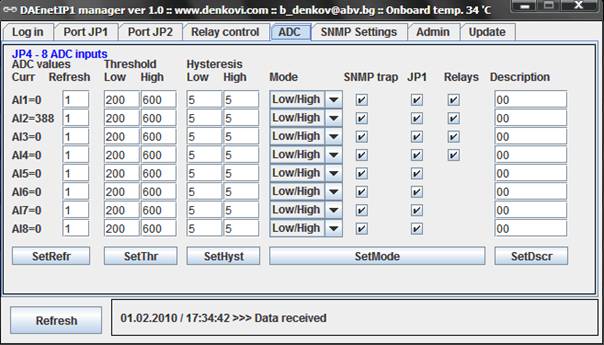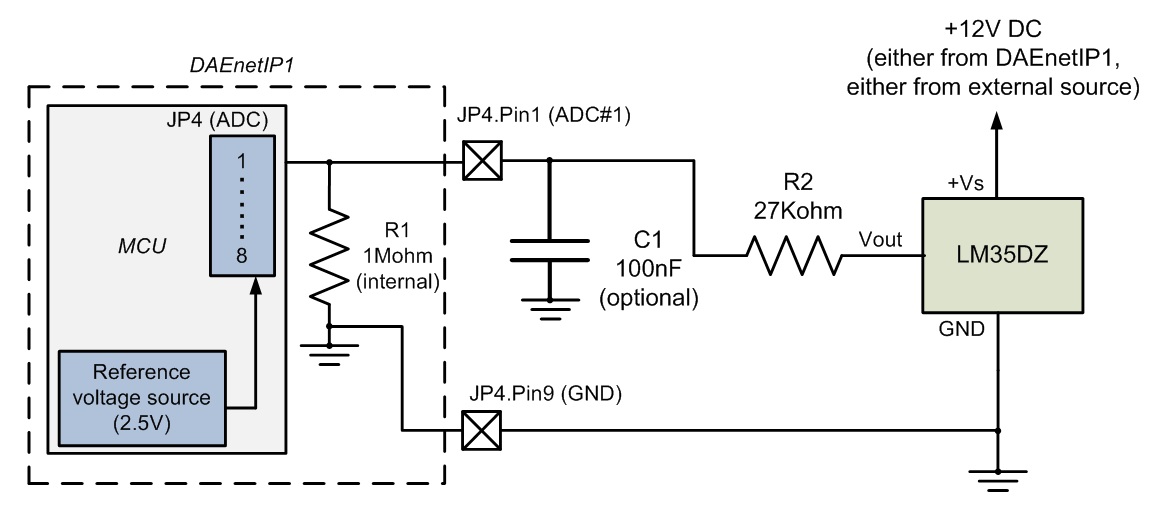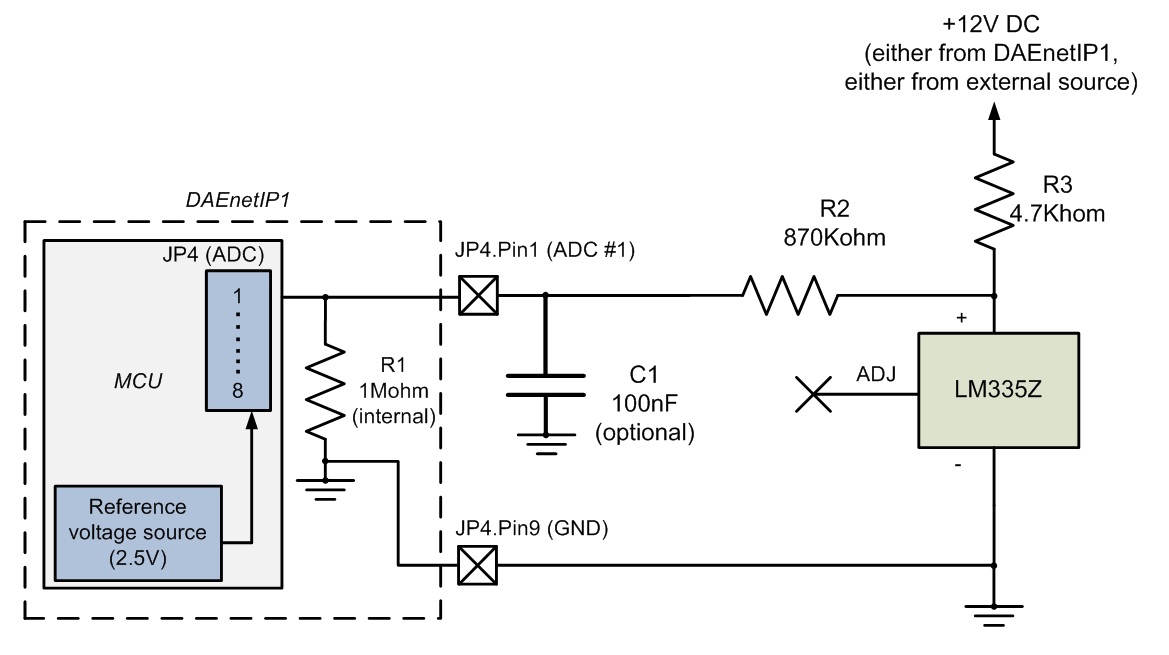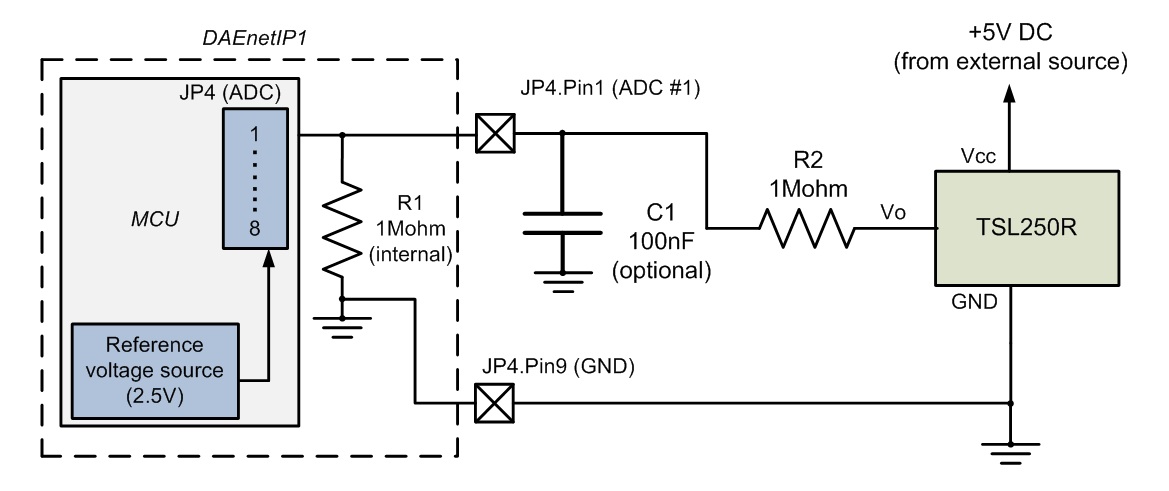This page is about how to connect analog sensors to DAEnetIP1 ethernet controller. In this way it is possible to measure different analog values like temperature, humidity, distance and control electrical device or send traps based on the meausred values.
- What is the purpose of this web page?
- For which devices is this tutorial?
- DAEnetIP1 ADC port (JP4)
- Connecting LM35DZ (temperature sensor)
- Connecting LM335 (temperature sensor)
- Connecting HIH-4000 (humidity sensor)
- Connecting GP2y0A21YK (distance sensor)
- Connecting TSL250R (light to voltage optical sensor)
What is the purpose of this web page?
This article main aim is to help you in projects where a various analog sensors must be connected to the inputs of our DAEnetIP1 controllers. In most of the cases, our DAEnetIP1 controllers can work with analog sensors like LM35DZ (temperatre), HIH-4000 humidity and so on... Some of these sensors are with linear voltage output and some of them not. In the first case, their value can be easily calculated with single equation (linearization by 2 points) and this can be easily done in the browser. In the second case, however this is not possible with this method but still such sensors can be used for triggers(to switch relay, send email). Here, we've put some example schematics how to connect such sensor to DAEnetIP1 controller.
We have created and small MS Excel file, which can help you to calculate tasks like:
- How to convert ADC units into sensor value (°C,m,%RH....). For example the browser showings of the ADC are in units (0-1023);
- How to convert sensor value into ADC units. For example when you want to set the low/high threshold but you know the sensor value is °C;
- Solve linearization by two points (which is required in software applications, where the ADC value can displayed directly in units like °C,m,%RH and so on); For example some applications require to enter sensor value in °C at 0 units and sensor value at 1024 unuts. This file will help you to solve them.
- Create custom software application showing ADC values in units like °C,m,%RH and so on;
For which devices is this tutorial ?
This tutorial may be useful for all customers that have the following devices:
|
Order number
|
Device name and link
|
| DAEnetIP1 | DAEnetIP1 |
| DAEnetIP1 + DAE-RB/Ro4_v2 | DAEnetIP1 Four Relay Board |
| DAEnetIP1 + DAE-RB/Ro8-JQC-12V | DAEnetIP1 Ethernet Eight Relay Board (ver. 1) |
The sensor must be connected to the DAEnetIP1 ADC port which is under the name JP4. Its location is marked on the image bellow. From JP3 it is possible to be taken and 12VDC for some sensors.
Below are listed example schematic connections for analog output sensors to DAEnetIP1 controller
Connecting LM35DZ (temperature sensor) to DAEnetIP1
- LM35DZ can be bought from our webshop eas well - here.
- LM35DZ is temperature sensor with linear voltage output, which can measure temperatures from 0°C up to 100°C
 LM35DZ datasheet - here
LM35DZ datasheet - here- The schematic is tested with 20 meters flat cable and works well in our laboratory. However for more noisy environment and longer cabel, an extra measurements may be required which are not object of this example.
- The power supply 12VDC for LM35DZ may be taken either from DAEnetIP1 either from external power source;
- The C1 capacitor is optional. It is recommend to be used if the sensor value is not constant.
- Settings for DAEnetIP1 Manager. First make SetThr, SetHyst, SetMode and then SetRefr. On the bellow image the ADC value is 388 units or that is about 97.28 °C

- Some data, which may help you:
|
Parameter
|
Value
|
Dimension | Note |
| ADCRes | 10 | bits | The resolution of the ADC |
| Vref | 2.5 | V | The referent voltage of the DAEnetIP1 controller |
| R1 | 1000 | Kohm | It is built-in the controller (see the above schematic) |
| R2 | 27 | Kohm | See the above schematic (must be connected additionaly) |
| SensMin | 0 | °C | The minimum value of the sensor |
| SensMax | 100 | °C | The maximum value of the sensor |
| SensorRes | 0.01 | V / °C | Sensor resolution, it is taken from the sensor datasheet |
| Vtest | 100 | °C | Testpoint value |
| Vvalue | 1 | V | Output voltage during the testpoint (Vtest) |
Connecting LM335Z (temperature sensor) to DAEnetIP1
- LM335Z can be bought from our webshop as well - here.
- LM335Z is temperature sensor with linear voltage output, which can measure temperatures from -40°C up to 100°C
 LM335Z datasheet - here
LM335Z datasheet - here- The schematic is tested with 20 meters flat cable and works well in our laboratory. However for more noisy environment and longer cabel, an extra measurements may be required which are not object of this example.
- The power supply 12VDC for LM335Z may be taken either from DAEnetIP1 either from external power source.
- The C1 capacitor is optional. It is recommend to be used if the sensor value is not constant.
- Settings for DAEnetIP1 Manager. The same way like LM35DZ example - first make SetThr, SetHyst, SetMode and then SetRefr. For example if the returned ADC value with the above schematic is 570 units, this means the temperature measured by LM335 is 27.2 °C
- Some data, which may help you:
|
Parameter
|
Value
|
Dimension | Note |
| ADCRes | 10 | bits | The resolution of the ADC |
| Vref | 2.5 | V | The referent voltage of the DAEnetIP1 controller |
| R1 | 1000 | Kohm | It is built-in the controller (see the above schematic) |
| R2 | 870 | Kohm | See the above schematic (must be connected additionaly) |
| SensMin | -40 | °C | The minimum value of the sensor |
| SensMax | 100 | °C | The maximum value of the sensor |
| SensorRes | 0.01 | V / °C | Sensor resolution, it is taken from the sensor datasheet |
| Vtest | 25 | °C | Testpoint value |
| Vvalue | 2.98 | V | Output voltage during the testpoint (Vtest) |
- The other sensors from this sieries are LM235 and LM135 - they can also be used with DAEnetIP1 the same way, however please refer to their specification.
Connecting HIH-4000 (humidity sensor) to DAEnetIP1
- HIH-4000 can be bought from our webshop as well - here
- HIH-4000 is humidity sensor with almost linear voltage output which can measure humidity from 0%RH upto 100%RH.
 HIH-4000 datasheet - here.
HIH-4000 datasheet - here.- The schematic is tested with 20 meters flat cable and works well in our laboratory. However for more noisy environment and longer cabel, an extra measurements may be required which are not object of this example.
- The power supply 5VDC for HIH-4000 must be taken from external power source.
- The C1 capacitor is optional. It is recommend to be used if the sensor value is not constant.
- Settings for web browser (to show directly in %RH): "Analog Inputs" -> Max = 134.04, Min = -28.94, Label = RH
- Some data, which may help you:
|
Parameter
|
Value
|
Dimension | Note |
| ADCRes | 10 | bits | The resolution of the ADC |
| Vref | 2.5 | V | The referent voltage of the DAEnetIP1 controller |
| R1 | 1000 | Kohm | It is built-in the controller (see the above schematic) |
| R2 | 1000 | Kohm | See the above schematic (must be connected additionaly) |
| SensMin | 0 | %RH | The minimum value of the sensor |
| SensMax | 100 | %RH | The maximum value of the sensor |
| SensorRes | 0.03068 | V / %RH | Sensor resolution, it is taken from the sensor datasheet |
| Vtest | 75.3 | %RH | Testpoint value |
| Vvalue | 3.198 | V | Output voltage during the testpoint (Vtest) |
Connecting GP2Y0A21YK (distance sensor) to DAEnetIP1
- GP2Y0A21YK can be bought from our webshop as well - here
- GP2Y0A21YK is infrared proximity sensor with non-linearity voltage output but it can still be used for triggering (to activate relay or send email).
 GP2Y0A21YK datasheet - here
GP2Y0A21YK datasheet - here- The schematic is tested with 20 meters flat cable and works well in our laboratory. However for more noisy environment and longer cabel, an extra measurements may be required which are not object of this example.
- The power supply 5VDC for GP2Y0A21YK must be taken from external power source;
- The C1 capacitor is optional. It is recommend to be used if the sensor value is not constant;
- The R1 pull-down resistor is built in the controller and the R2 must be connected externaly;
- You can use and the other Sharp sensor 20-150cm sensor the same way - http://denkovi.com/infrared-proximity-sensor-20-150cm
Connecting TSL250R (light to voltage optical sensor) to DAEnetIP1
- TSL250R can be bought from our webshop as well - here
- TSL250R is light to voltage optical sensor with non-linearity voltage output but it can still be used for trigger (to activate relay or send snmp trap).
 TSL250R datasheet - here
TSL250R datasheet - here- The schematic is tested with 20 meters flat cable and works well in our laboratory. However for more noisy environment and longer cabel, an extra measurements may be required which are not object of this example.
- The power supply 5VDC for TSL250R must be taken from external power source;
- The C1 capacitor is optional. It is recommend to be used if the sensor value is not constant.
- The R1 pull-down resistor is built in the controller and the R2 must be connected externaly;
- The other sensors from this sieries are TSL251R and TSL252R - they can also be used with DAEnetIP1 the same way, however please refer to their specification
Last update: 09 May 2014
.png)
.png)














